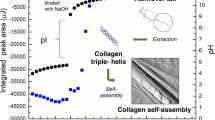Abstract
Take bovine tendon type-I collagen as the raw material, we pretreated it by freezing and then grinding the macromolecule at a low temperature (4–10 °C). Effects of the grinding process on the molecular structure, water solubility, fibrillogenesis behavior in vitro and biological activity of collagen were systematically prospected. Sodium dodecyl sulfate–polyacrylamide gel electrophoresis (SDS–PAGE) results revealed that the collagen had typical structural characteristics of type-I collagen; moreover, grinding treatment gave rise to partially degraded collagen molecules which took on continuous bands with lower molecular weights different from α1 and α2. More strikingly, the degradation degree positively corresponded to the grinding duration. Circular dichroism (CD) analysis manifested that with extended grinding, intensities of both the positive and negative peaks for collagen samples shrunk. Interestingly, grinding also contributed to improved water solubility of collagen. The water solubility of the sample ground for 20 min (COL20) was 1.91 mg/mL, which is about 6 times higher than that of the natural collagen sample (0.28 mg/mL). Amid the study concerning the fibrillogenesis behavior, turbidity and rheological data collaboratively demonstrated that with prolonged grinding time, the assembly rate and degree of the sample plunged. Assembled gel from the ground collagen with finer fibrils was also observed in scanning electron microscope (SEM), which further embraced the conclusion aforementioned in fibrillogenesis kinetics. Cell experiments corroborated that the grinding process can be harnessed to manipulate the cell proliferation promoting ability of collagen. Simultaneously, further dissection of COL20 with the best biological activity clarified that the water-soluble part and water-insoluble part of COL20 had distinct aptitudes as to promoting cell proliferation as well as inhibiting the growth of liver cancer cells.
Graphical abstract

Cryogrinding treatment, which may give rise to physical and chemical changes of substances out of its prominent mechanical force on specimens, was utilized to modulate performances of collagen, including its water solubility, gel properties and biological capacities. The resultant collagen powder with improved water solubility and bioactivity is expected to expedite its actual processing and applications.







Similar content being viewed by others
Availability of data and materials
The data sets generated during and/or analysed during the current study are available from the corresponding author on reasonable request.
References
S.W. Kim, H.K. Bae, H.S. Nam, D.J. Chung, P.H. Choung, Macromol. Res. 14, 673 (2006)
W. Wang, F. Shu, L. Pan, S. Huang, X. Tu, P. Li, S. Li, Y. Li, C. Xu, Y. Sun, J. Zhang, H. Wang, Macromol. Res. 28, 636 (2020)
M. Sun, X. Wei, H. Wang, C. Xu, B. Wei, J. Zhang, L. He, Y. Xu, S. Li, Food Bioprocess Tech. 13, 367 (2020)
I. Ismail, Y.-H. Hwang, S.-T. Joo, Food Bioprocess Tech. 12, 1000 (2019)
T.K.J. Gert, V.P. Rimke, HFP Ingredients B.V., Groningen (NL), US Patent 20130210713 A1 (2017)
D. Chen, S. Yin, J. Yang, J. Yi, C. Ye, Guangzhou Trauer Biotechnology Co., Ltd., CN Patent 114106152 A (2022)
L. He, J. Yang, Xu. Chengzhi, S. Li, B. Wei, J. Zhang, Xu. Yuling, H. Wang, New J. Chem. 44, 6760 (2020)
T. Xiao, X. Chen, Y. Peng, J. Nan, B. Wei, L. He, X. Chengzhi, D.X. Xu, J. Zhang, H. Wang, Macromol. Res. 26, 1233 (2018)
M. Abdollahi, M. Rezaei, A. Jafarpour, I. Undeland, Food Chem. 242, 568 (2018)
C. Xu, N. Jie, C. Dai, B. Wei, J. Zhang, H. Lang, H. Wang, Dry Technol. 36, 1031 (2017)
J. Zhang, Tu. Xiao, W. Wang, J. Nan, B. Wei, Xu. Chengzhi, L. He, Xu. Yuling, S. Li, H. Wang, Int. J. Biol. Macromol. 128, 885 (2019)
P.K. Bhagwat, P.B. Dandge, Biocatal. Agr. Biotech 7, 234 (2016)
A.H. Abdel-Alim, A.E. Hamielec, J. Appl. Polym. Sci. 17, 3769 (2010)
C. Mu, D. Li, W. Lin, Y. Ding, G. Zhang, Biopolymers 86, 282 (2007)
H. Wang, Y. Liang, H. Wang, H. Zhang, M. Wang, L. Liu, J. Aquat. Food Prod. T. 23, 264 (2014)
P. Noitup, M.T. Morrissey, W. Garnjanagoonchorn, J. Food Biochem. 30, 547 (2006)
L. He, S. Li, X. Chengzhi, B. Wei, J. Zhang, X. Yuling, B. Zhu, Y. Cao, W. Xilin, Z. Xiong, R. Huang, J. Yang, H. Wang, Macromol. Res. 28, 861 (2020)
A. Menke, C. Philippi, R. Vogelmann, B. Seidel, D. Wedlich, Cancer Res. 61, 3508 (2001)
R. Xing, L. Kai, T. Jiao, Z. Ning, X. Yan, Adv. Mater. 28, 3669 (2016)
V. Frappier, J.M. Jenson, J. Zhou, G. Grigoryan, A.E. Keating, Structure 27, 606 (2019)
Acknowledgements
This study was supported by the National Natural Science Foundation of China (No. 22178277).
Funding
National Natural Science Foundation of China, 22178277, haibo wang.
Author information
Authors and Affiliations
Contributions
YX, LH, HW: conceptualization, methodology, software; LD, KL: data curation, writing—original draft preparation; JL, LD: visualization, investigation; CX, BW: supervision; JZ: software, validation, writing—reviewing and editing.
Corresponding authors
Ethics declarations
Conflict of interest
The author of the paper does not declare a competitive fiscal gain.
Ethical approval
Not applicable.
Additional information
Publisher's Note
Springer Nature remains neutral with regard to jurisdictional claims in published maps and institutional affiliations.
Supplementary Information
Below is the link to the electronic supplementary material.
Rights and permissions
Springer Nature or its licensor (e.g. a society or other partner) holds exclusive rights to this article under a publishing agreement with the author(s) or other rightsholder(s); author self-archiving of the accepted manuscript version of this article is solely governed by the terms of such publishing agreement and applicable law.
About this article
Cite this article
Xu, Y., Dai, L., Li, K. et al. Ground type-I collagen—a focused study on its fibrillogenesis behavior and bioactivity in vitro. Macromol. Res. 31, 75–83 (2023). https://doi.org/10.1007/s13233-022-00108-3
Received:
Revised:
Accepted:
Published:
Issue Date:
DOI: https://doi.org/10.1007/s13233-022-00108-3




